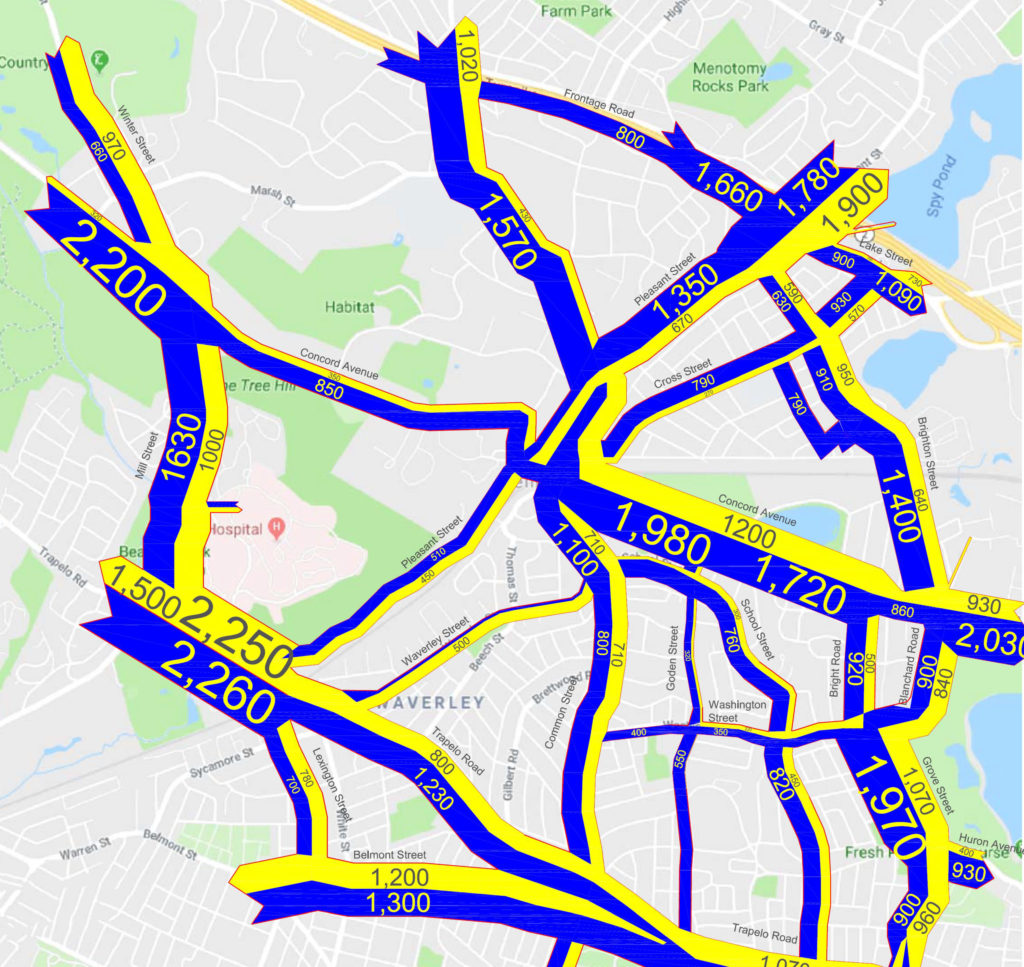By Jessie Bennett
Traffic in greater Boston has gone from an annoyance to a crisis. The recent Congestion in the Commonwealth study produced by the Massachusetts Department of Transportation (MassDOT), outlines how increasing congestion is affecting travel times and access to jobs.
Two key trouble areas are Fresh Pond Parkway and the Route 2 approach to Alewife. High congestion in these areas causes the cut-through traffic noted in Belmont’s Town Wide Traffic Study, presented by BSC Group in April.
If cars are gridlocked in one area, drivers will look for other ways around it, either by using GPS apps or by experimentation. The waves of cars entering Belmont at Park Avenue and Pleasant Street, traveling down Concord Avenue, Brighton and Blanchard streets are avoiding the bottleneck on Route 2. Cut-through traffic also likely contributes to cars entering Belmont via Concord Avenue from Lexington and via Trapelo Road from Waltham.

Morning travel (7-9 AM) traffic numbers in Belmont. Yellow roads show north/west traffic. Dark blue roads show south/east traffic. Source: “Town Of Belmont Town Wide Traffic Study,” BSC Group, April 1, 2019.
As the saying goes, “You aren’t IN traffic: you ARE traffic.” Many of us choose to drive instead of taking public transit due to many factors: ease of access, perceived reliability, weather, assumptions about safety, individual schedules, habit, and comfort. The wide variation in weather conditions and daylight hours throughout the year in New England also affects decisions. On any given day, a “hiccup” in any of these systems could result in far longer driving travel times.
In commute planning, each of us considers the lack of accessibility at many points in the transit system (especially if we need to navigate a stroller or have mobility challenges) as well as crowding on the T at peak times. Parents add the need to drop off and pick up kids to their calculations. I remember times when I’ve been stuck on the T between stations, wondering if I would make it to our daycare in time to avoid being penalized. I’ve stood in the Harvard Square busway, wondering if the 75 would perform the “disappearing bus trick,” where the bus I’ve been tracking on my phone seemingly vanishes, leaving me to wait another 20 minutes for the next one.
Personal decisions about transit affect the community directly every day. Our choices have an immediate impact on local air quality; our carbon emissions contribute to global climate change. Transportation accounts for nearly a third of US greenhouse gas emissions, and a majority of those emissions are from cars.
Increased traffic in our neighborhoods also affects the quality of life in those neighborhoods and how safe we feel as pedestrians. When a neighborhood street lacking adequate sidewalks and safe crossings sees a dramatic spike in traffic, the walkability of that street takes a tremendous hit.
So what are we doing in Belmont to address these issues?
The Transportation Advisory Committee is developing a traffic-calming policy to help neighborhood streets affected by speeding and cut-through traffic. Streets will be considered for traffic calming when they come up for repaving through the Pavement Management Program (PMP) or if residents petition the town for relief. Changes to the PMP in 2018 allow money to be spent on sidewalks, but funding for dramatic improvements will be harder to find.
A $1.3 million Safe Routes to Schools project through the Massachusetts Department of Transportation will improve conditions near the Wellington School. It is scheduled for 2021.
The town received a state grant this spring to improve the Lexington and Sycamore intersection where a Belmont woman was tragically killed in 2018.
Improvements to pedestrian and bicycling infrastructure are underway in the Hittinger neighborhood and planned for the Goden and School neighborhoods.
The town is working with a consultant to help prioritize projects for the Complete Streets funding program. Once the priorities are set, the town will submit a five-year plan. Belmont will be eligible for up to $400,000 a year for projects that serve pedestrians, bicyclists, and transit users as well as motorists.
The Community Path will vastly improve bicycle infrastructure in town and help get more commuters in the western suburbs out of their cars.
The High School Traffic Working Group was formed by the Select Board in response to concerns over the impacts on neighborhoods abutting the Belmont Middle and High School.
These approaches can help mitigate traffic’s impact in Belmont, but we cannot eliminate our traffic woes by taking action only at the local level. Any attempts to redirect cut-through traffic will also affect residents and will only work as long as the traffic does not worsen.
As demonstrated in the MassDOT report, congestion is a regional issue and calls for regional solutions. State Senator Will Brownsberger has been active on this issue. I recommend his blog at WillBrownsberger.com for updates.
We can also get involved in regional advocacy through groups like Transit Matters, which is dedicated to improving Boston area transit, and by staying informed about the MBTA and the Baker administration’s plans for transportation. A better, less congested future is possible only through good planning and financial investments.
Jessie Bennett has lived in Belmont for 12 years and is a Precinct 1 Town Meeting Member. She chairs of the High School Traffic Working Group and is a member of the Transportation Advisory Committee and the Belmont Safe Routes to Schools group.


Sorry, the comment form is closed at this time.